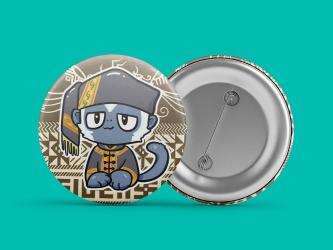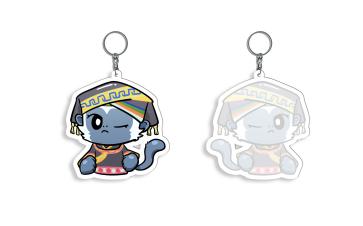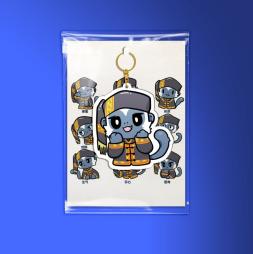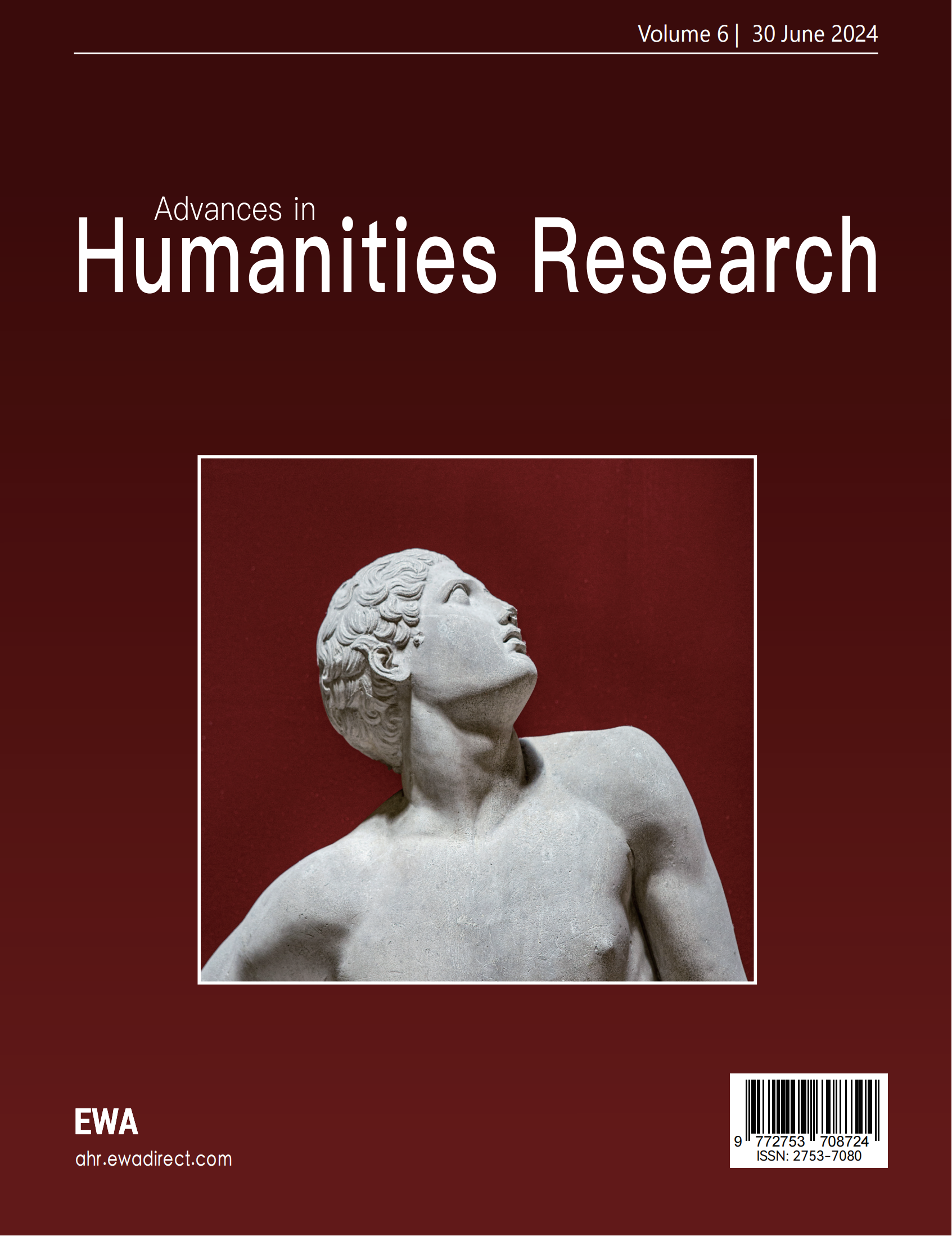1. Introduction
The Zhuang ethnic group is one of the largest minority groups in China, with a rich cultural tradition and unique folk customs. The "Furui" culture, as a trendy cultural phenomenon, has rapidly developed domestically and internationally in recent years, bringing new vitality to traditional folk culture. This paper takes the example of Zhuang Furui culture dolls to explore how to integrate traditional culture with modern design, promoting cultural heritage and dissemination. By thoroughly studying the connotations and characteristics of Zhuang traditional clothing culture and applying them to the design of Furui dolls, unique cultural and creative products are launched, injecting new vitality into the Zhuang cultural tourism industry. However, with the acceleration of modernization, many traditional customs are gradually disappearing, necessitating measures for their protection and inheritance. As an emerging cultural phenomenon, Furui culture, with its distinct cross-cultural characteristics, is increasingly accepted and loved by people domestically and internationally. The influence of Furui culture is expanding, gradually becoming an international cultural phenomenon. In terms of the integration of culture and design, existing research mainly focuses on the innovation of design concepts, the application of traditional elements, and the expression of cultural connotations. In his book "Introduction to Art Design," Li Yanzu emphasizes the importance of traditional elements in modern design and proposes a series of ideas and methods for incorporating traditional elements into modern design.[1] Additionally, some studies explore how to integrate cultural elements of different ethnic groups into modern design to achieve cultural exchange and heritage. In his book "Ethnic Art and Modern Design," Lu Hongyang analyzes the artistic characteristics of different ethnic groups and their impact on modern design, proposing some guiding design principles and methods.[2] This paper aims to achieve cultural integration and inheritance by combining Furui culture with Zhuang culture, deeply exploring the connotations of Zhuang clothing culture, and applying them to the design and production of Furui dolls. This approach aims to inject new vitality into the Zhuang cultural tourism industry, attracting more tourists and doll enthusiasts, thereby promoting the development of tourism in the Zhuang regions.
2. Overview of Fu Rui Culture and Zhuang Culture
2.1. Origin and Development of Fu Rui Culture
Fu Rui, a transliteration of the English term "Furry," typically refers to furry, anthropomorphic animal characters. [3] The origins of Fu Rui culture can be traced back to the 1980s, initially taking shape in the United States. Driven by the rise of the internet and technological advancements, it has gradually grown into a substantial global community. The roots of Fu Rui culture lie with enthusiasts of comic strips, animations, and fictional narratives who began to create characters that embody both human and animal traits. These characters serve as a medium for creativity and imagination, as well as a means to express a passion for animals, nature, and fantasy through role-playing, art, literature, and virtual gaming.
2.2. Characteristics and Values of Zhuang Culture
The Zhuang is an ethnic minority in China with a long history and a wealth of cultural traditions. Zhuang culture is renowned for its unique customs, ethnic music, dance, opera, and attire. It emphasizes family values and collectivism, advocating for a natural, harmonious, and peaceful way of life. The Zhuang people are highly regarded for their kindness, diligence, and resilience. [4] Due to their natural environment and specific modes of production, the ancestors of the Zhuang developed a distinctive material and spiritual culture over their long historical evolution, reflecting the characteristics of ethnic and regional culture.
The value of Zhuang culture lies in the protection and inheritance of ethnic cultural heritage and the promotion of the integration and development of multiculturalism. The richness and uniqueness of Zhuang culture make a significant contribution to the diversity of Chinese culture. For the Zhuang people, their culture is a vital source of self-identification and cultural identity, and it is also an important symbol of their distinctiveness and diversity in the context of globalization.
2.3. The History and Clothing Characteristics of the Black-Cloth Zhuang
The Black-Cloth Zhuang is a branch of the Zhuang ethnic group in Guangxi, specifically the Bu'ao and Bumin tribes [5]. The Black-Cloth Zhuang takes black as their symbol of beauty, which serves as a mark of their ethnicity. It is said that in ancient times, when foreign tribes invaded the territory of the Black-Cloth Zhuang, the chieftain Nong Laofa led his troops to resist but was unfortunately injured. While retreating into the dense forest to hide, he discovered a patch of green wild indigo. He picked the indigo leaves and mashed them to apply on his wound, which unexpectedly had the effect of reducing swelling and relieving pain, and his wound healed quickly. Nong Laofa returned to the battlefield with his troops, repelled the enemy, and defended his homeland. Subsequently, Nong Laofa ordered his people to transplant the wild indigo and dye their clothes with it. The members of the tribe all wore black clothing dyed with indigo as their ethnic mark, a tradition that has continued to this day. The name "Black-Cloth Zhuang" also originated from this.
The clothing of the Black-Cloth Zhuang is still one of the most traditional, characteristic, and meaningful Zhuang ethnic costumes. It uses black as a mark for both attire and ethnicity, and it emphasizes practicality in wear. The style is generous, simple, and elegantly beautiful, with a distinctive grace. The unique skirt set worn by the Black-Cloth Zhuang is rarely seen in other Zhuang areas of Guangxi. This attire shows a three-dimensional sense of hierarchy, making people appear lively and elegant. When going to the market or visiting relatives and friends, the apron can be rolled up to be used as a pocket, and it can also hold a small amount of beans and miscellaneous grains during labor. The horn-shaped headscarf worn by Black-Cloth Zhuang women is also rare in the costumes of other Zhuang areas. The aesthetic consciousness that admires black forms the unique regional costume culture of the Black-Cloth Zhuang. Men wear a front-covered jacket with wide-legged, loose-fitting trousers, which is convenient for their labor and walking in the mountains.
2.4. Cultural Connotation of the Zhuang Fu Rui Cultural Dolls
Clothing serves not only as protection against the cold and a means of enhancing beauty but also acts as an identifier among different ethnic groups and within the same group for different social statuses and roles. It possesses a social contract function and a normative control social role, becoming a sign that indicates or constrains people's behavior [6]. In traditional Zhuang society, clothing had the function of an ethnic emblem to distinguish one group from another, served as an identifier for social roles, and was also a symbol of status and rank, becoming a symbol to mark a person's social status, role, and rank. The Zhuang Fu Rui cultural dolls are creative design works that combine Zhuang costume culture with Fu Rui culture, showing a unique cultural connotation.
The cultural connotation of the Zhuang Fu Rui cultural dolls is reflected in several aspects. Firstly, through the integration of the traditional costume culture of the Black-Clothed Zhuang, these dolls showcase the characteristics and traditional beauty of the Zhuang ethnicity. Known for their generous styles, simple and beautiful appearance, and preference for black, these traditional features are incorporated into the costume design of the dolls to display the cultural charm of the Zhuang people.
Secondly, the fusion of Zhuang costume culture and Fu Rui culture is embodied in the Zhuang Fu Rui cultural dolls. This integration retains the characteristics of traditional Zhuang attire while also incorporating modern elements of Fu Rui culture. Zhuang costumes are typically noted for their vibrant colors, intricate patterns, and exquisite embroidery. By combining these two cultural elements, the dolls present a unique visual effect in their appearance, full of creativity and artistic sensibility.
Lastly, the integration of Zhuang costume culture and Fu Rui culture is not just a physical combination but also a blend in terms of cultural connotation and the conveyance of meaning. This fusion not only makes Zhuang clothing more creative but also extends the reach and attention that Fu Rui culture receives in the Zhuang regions. [7] The vitality and sustainability of any ethnic culture depend on its continuous innovation, enrichment, and development.
3. Integration of Zhuang Costume Culture and Fu Rui Culture
3.1. Case Study of the Combination of Zhuang Fu Rui Culture and the White-headed Langur Doll
To delve into the role of cultural and creative products in the inheritance and promotion of minority cultures, a case study analysis method can be employed. Initially, an in-depth study of Zhuang costume culture is conducted to uncover its connotations and characteristics. Subsequently, the elements of Zhuang costume are integrated into the costume design of Fu Rui dolls, taking into account the distinctive features of Fu Rui culture. Finally, online surveys are distributed to gauge public opinion, ensuring that the cultural and creative designs meet the tastes and needs of the masses. Observations are made regarding the acceptance level of such products, and feedback is collected to refine the product design and explore development directions. Preliminary research samples indicate that over 85% of respondents support the integration and innovation of Fu Rui culture and Zhuang culture, while over 90% believe this integration enhances cultural diversity and aids in the transmission and promotion of Zhuang culture. Therefore, feedback from the public can continuously optimize products and drive innovation in the cultural and creative industry.
Next, focusing on the characteristics of Fu Rui culture, the White-headed Langur is chosen as the carrier. Fu Rui culture is a subculture that emphasizes the love and respect for animal imagery, and Zhuang culture also includes beliefs and symbols related to animals. For instance, in Zhuang culture, the buffalo symbolizes diligence and dedication, the goose is considered a lucky creature, and the tiger represents the mountain deity. Thus, using the White-headed Langur as a cultural carrier highlights the spirit of loving small animals in Fu Rui culture and combines it with the image of the White-headed Langur to design Fu Rui dolls with distinctive Zhuang characteristics. Fu Rui enthusiasts often enjoy role-playing animals dressed in human-like, characteristic clothing, which is precisely the combination of human and animal traits they pursue in character design. The White-headed Langur, a primate belonging to the leaf monkey genus, is characterized by a small head, slender body, long limbs, and a tail longer than its body. Its fur is primarily black, with a distinctive white tuft of hair on its head, resembling a pointed white top hat, and white fur on the neck and shoulders, with the upper half of the tail being black, presenting a striking and beautiful appearance. Mainly distributed in the southern Guangxi region of China, including Fuxin, Chongzuo, Ningming, and Longzhou, the White-headed Langur inhabits the transitional zone from tropical to subtropical climates, under a tropical monsoon climate [8]. Currently, there are no live specimens or specimens of the White-headed Langur abroad, and it is recognized as one of the world's rarest monkeys. They typically inhabit the tall trees of the jungle, are adept at jumping and climbing, and live in groups, mainly divided into several families or small groups. They are herbivorous, feeding primarily on leaves, buds, fruits, and bark. The combination of the White-headed Langur with Fu Rui culture not only enriches the content and form of expression of Fu Rui culture but also provides a new direction for the protection of the White-headed Langur. Its unique appearance and distinctive features are well-suited for designing Fu Rui characters, incorporating the white hair on the head, dark fur, and slender limbs into the design to enhance the character's individuality and uniqueness. Through the promotion of Fu Rui culture, more people can learn about and understand this rare animal, raising awareness for their protection. At the same time, attention can be drawn to the living environment of the White-headed Langur, promoting the development of its natural conservation efforts.
Zhuang Fu Rui cultural dolls, as cultural and creative products with profound connotations, showcase the uniqueness and diversity of the Zhuang ethnicity and provide a new entry point for cultural exchange and inheritance [9]. Through the vivid image of the White-headed Langur doll, these dolls convey the profound essence of Zhuang costume culture, representing not only the spirit of cultural innovation but also the unique charm and love and care for small animals brought about by the combination of Zhuang culture and Fu Rui culture. Today, too many rare animals are on the path to extinction, or have already become extinct and disappeared from our human view, which is a heartbreaking end. Therefore, we must contribute to the protection of animals, promote the concept of protecting animals, and let more people understand the importance of protecting animals, so that people can love their animal friends together. Protecting the White-headed Langur and other endangered animals faces many challenges and requires the joint efforts and cooperation of the public and businesses to draw attention and protect these precious species, achieving harmonious coexistence with nature.
The promotion of such cultural and creative products not only helps to enhance the inheritance and promotion of ethnic culture but also promotes exchanges among Zhuang culture and Fu Rui culture enthusiasts. By showcasing the cultural charm of the Zhuang ethnicity to the public, we can stimulate more people's interest in Zhuang culture and promote the diversified development of culture.



Figure 1. Samples
4. Conclusion
Through in-depth research on Zhuang ethnic attire, specifically the distinctive Black-Clothed Zhuang, we have identified unique characteristics in color matching and material selection that provide valuable inspiration for the design of Fu Rui dolls. In the design process of these dolls, typical elements of Zhuang costume have been integrated into the dolls' shapes, clothing, and accessories, creating distinctive cultural and creative products. Market research indicates a high level of acceptance for these products. This is reflected in: firstly, public appreciation for the exterior design of the Fu Rui dolls; secondly, recognition of the Zhuang cultural connotations represented by the dolls; and lastly, satisfaction with the pricing and cost-effectiveness of the dolls. However, valuable feedback was also received, such as desires for more detailed craftsmanship and the addition of interactive features. Based on this feedback, we have made improvements and refinements to the products.
This study explores the integration and inheritance of minority culture with modern design by combining Zhuang costume culture with Fu Rui culture. The core value of culture is based on regional historical and cultural resources, which helps to highlight local characteristics, enhance competitiveness, and attractiveness. The results show that applying traditional cultural elements to modern design is feasible and contributes to increasing the added value and market competitiveness of products. Moreover, this integration also aids in promoting minority cultures and stimulating local economic development. However, practical considerations must be addressed, such as how to better integrate traditional elements with modern design and how to improve product quality and added value. Therefore, future research directions should include in-depth discussions on the theories and practices of combining culture with design, and further enhancing product quality and market competitiveness.
References
[1]. Li, Y. (2009). Introduction to art design. Wuhan: Hubei Fine Arts Publishing House.
[2]. Lu, H. (2010). Ethnic art and modern design. Beijing: China Light Industry Press.
[3]. Qin, D. (2006). Traditional characteristics and modern construction of Zhuang culture. Nanning: Guangxi People's Publishing House.
[4]. Chen, L. (2009). Research on Zhuang costume culture. Ethnic Publishing House.
[5]. Huang, C. (2002). Chinese white-headed langur. Guangxi Normal University Press.
[6]. Huang, Z. (2000). Preliminary reading of "Anthropological study of the black-clothed Zhuang". Journal of Baise University.
[7]. Niu, X. (2019). "Animal fans" Weibo performance: Self-presentation based on social media. In China Media Technology.
[8]. Huang, C., Xue, Y., Wei, Y., & Li, Y. (2000). Research on the habitat and habitat selection of the white-headed langur. Acta Theriologica Sinica.
[9]. Fan, L., & Chen, H. (2023). Research on the integration path of culture and tourism industry. Science and Technology Times.
Cite this article
Li,Y.;Yuan,F. (2024). Innovative Design and Application of Ethnic Cultural and Creative Products: A Case Study of the Zhuang Fu Rui Cultural Dolls. Advances in Humanities Research,6,33-36.
Data availability
The datasets used and/or analyzed during the current study will be available from the authors upon reasonable request.
Disclaimer/Publisher's Note
The statements, opinions and data contained in all publications are solely those of the individual author(s) and contributor(s) and not of EWA Publishing and/or the editor(s). EWA Publishing and/or the editor(s) disclaim responsibility for any injury to people or property resulting from any ideas, methods, instructions or products referred to in the content.
About volume
Journal:Advances in Humanities Research
© 2024 by the author(s). Licensee EWA Publishing, Oxford, UK. This article is an open access article distributed under the terms and
conditions of the Creative Commons Attribution (CC BY) license. Authors who
publish this series agree to the following terms:
1. Authors retain copyright and grant the series right of first publication with the work simultaneously licensed under a Creative Commons
Attribution License that allows others to share the work with an acknowledgment of the work's authorship and initial publication in this
series.
2. Authors are able to enter into separate, additional contractual arrangements for the non-exclusive distribution of the series's published
version of the work (e.g., post it to an institutional repository or publish it in a book), with an acknowledgment of its initial
publication in this series.
3. Authors are permitted and encouraged to post their work online (e.g., in institutional repositories or on their website) prior to and
during the submission process, as it can lead to productive exchanges, as well as earlier and greater citation of published work (See
Open access policy for details).
References
[1]. Li, Y. (2009). Introduction to art design. Wuhan: Hubei Fine Arts Publishing House.
[2]. Lu, H. (2010). Ethnic art and modern design. Beijing: China Light Industry Press.
[3]. Qin, D. (2006). Traditional characteristics and modern construction of Zhuang culture. Nanning: Guangxi People's Publishing House.
[4]. Chen, L. (2009). Research on Zhuang costume culture. Ethnic Publishing House.
[5]. Huang, C. (2002). Chinese white-headed langur. Guangxi Normal University Press.
[6]. Huang, Z. (2000). Preliminary reading of "Anthropological study of the black-clothed Zhuang". Journal of Baise University.
[7]. Niu, X. (2019). "Animal fans" Weibo performance: Self-presentation based on social media. In China Media Technology.
[8]. Huang, C., Xue, Y., Wei, Y., & Li, Y. (2000). Research on the habitat and habitat selection of the white-headed langur. Acta Theriologica Sinica.
[9]. Fan, L., & Chen, H. (2023). Research on the integration path of culture and tourism industry. Science and Technology Times.









